- Arabic
- French
- Russian
- Spanish
- Portuguese
- Turkish
- Armenian
- English
- Albanian
- Amharic
- Azerbaijani
- Basque
- Belarusian
- Bengali
- Bosnian
- Bulgarian
- Catalan
- Cebuano
- Corsican
- Croatian
- Czech
- Danish
- Dutch
- Afrikaans
- Esperanto
- Estonian
- Finnish
- Frisian
- Galician
- Georgian
- German
- Greek
- Gujarati
- Haitian Creole
- hausa
- hawaiian
- Hebrew
- Hindi
- Miao
- Hungarian
- Icelandic
- igbo
- Indonesian
- irish
- Italian
- Japanese
- Javanese
- Kannada
- kazakh
- Khmer
- Rwandese
- Korean
- Kurdish
- Kyrgyz
- Lao
- Latin
- Latvian
- Lithuanian
- Luxembourgish
- Macedonian
- Malgashi
- Malay
- Malayalam
- Maltese
- Maori
- Marathi
- Mongolian
- Myanmar
- Nepali
- Norwegian
- Norwegian
- Occitan
- Pashto
- Persian
- Polish
- Punjabi
- Romanian
- Samoan
- Scottish Gaelic
- Serbian
- Sesotho
- Shona
- Sindhi
- Sinhala
- Slovak
- Slovenian
- Somali
- Sundanese
- Swahili
- Swedish
- Tagalog
- Tajik
- Tamil
- Tatar
- Telugu
- Thai
- Turkmen
- Ukrainian
- Urdu
- Uighur
- Uzbek
- Vietnamese
- Welsh
- Bantu
- Yiddish
- Yoruba
- Zulu
ഒക്ട് . 16, 2024 03:56 Back to list
Understanding the Importance of Car Engine Belts for Vehicle Performance and Maintenance
Understanding Car Engine Belts The Unsung Heroes of Automotive Performance
When we think about the intricate workings of a car, our minds often jump to the engine, tires, or the latest high-tech gadgets that adorn modern vehicles. However, one critical component that plays a vital role in ensuring the efficient operation of an engine is often overlooked the engine belt. These essential parts are responsible for connecting various components of the engine, allowing them to work in harmony and maintain the vehicle's overall performance.
What Are Engine Belts?
Engine belts, often referred to as serpentine belts or accessory belts, are flexible and durable loops made of materials like rubber or reinforced fiber. They are designed to transfer power from the engine's crankshaft to various accessories, including the alternator, water pump, power steering pump, and air conditioning compressor. The primary function of these belts is to keep everything running smoothly and to prevent any disruption in the engine's operations.
Types of Engine Belts
There are generally two types of belts used in cars the serpentine belt and the timing belt
.1. Serpentine Belt This is the more common type found in most modern vehicles. It is a long, continuous belt that wraps around multiple pulleys in the engine. Its design allows it to drive multiple components simultaneously, making it efficient and effective. It also typically features a ribbed underside to enhance grip and reduce slippage.
2. Timing Belt Unlike the serpentine belt, the timing belt is critical for maintaining the timing of the engine’s internal components. It ensures that the crankshaft and camshaft rotate in sync, which is crucial for maintaining the engine's efficiency and preventing catastrophic failures. Timing belts are usually made of a more robust material and are designed to last longer but may require replacement after a specific mileage or time period.
car engine belt

Importance of Regular Maintenance
Like all mechanical components, engine belts are subject to wear and tear. Factors such as heat, dust, and exposure to oil can significantly affect their lifespan. As a result, regular maintenance is essential. It is prudent to check the condition of the belts during routine oil changes, looking for signs of wear such as cracks, fraying, or discoloration.
Most expert mechanics recommend replacing the serpentine belt every 60,000 to 100,000 miles, while the timing belt may need to be replaced between 70,000 and 100,000 miles, depending on the manufacturer’s recommendations. Ignoring these replacement schedules can lead to engine failure, resulting in costly repairs and unsafe driving conditions.
Signs of a Failing Engine Belt
Drivers should be aware of warning signs that indicate a potential problem with their vehicle's engine belt. Unusual noises, such as squeaking or squealing sounds, can indicate that the belt is becoming loose or worn. Additionally, if the power steering feels heavy, the air conditioning is not functioning correctly, or warning lights illuminate on the dashboard, it may be time to get the belts inspected.
Conclusion
In conclusion, while car engine belts may not be the most glamorous aspect of automotive engineering, they are undoubtedly among the most critical components. Understanding their function, the types available, and the importance of regular maintenance can help ensure that your vehicle runs smoothly and efficiently. By taking care of your engine belts, you are not only prolonging the life of your vehicle but also enhancing your overall driving experience. Don't wait for a warning sign; prioritize your car's health today!
-
Korean Auto Parts Timing Belt 24312-37500 For Hyundai/Kia
NewsMar.07,2025
-
7PK2300 90916-T2024 RIBBED BELT POLY V BELT PK BELT
NewsMar.07,2025
-
Chinese Auto Belt Factory 310-2M-22 For BMW/Mercedes-Benz
NewsMar.07,2025
-
Chinese Auto Belt Factory 310-2M-22 For BMW/Mercedes-Benz
NewsMar.07,2025
-
90916-02660 PK Belt 6PK1680 For Toyota
NewsMar.07,2025
-
drive belt serpentine belt
NewsMar.07,2025

